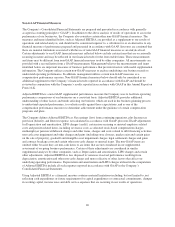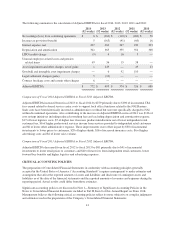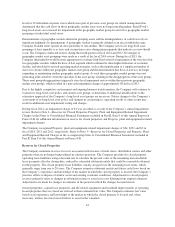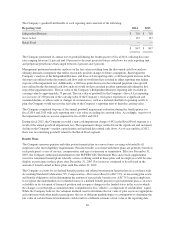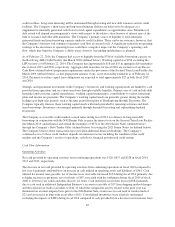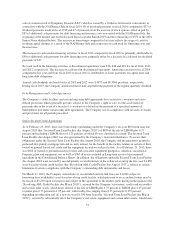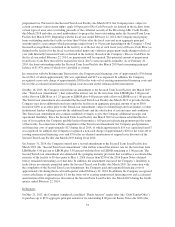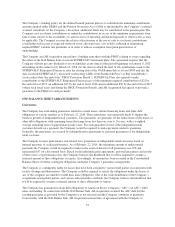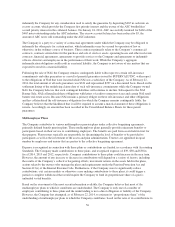Albertsons 2014 Annual Report Download - page 51
Download and view the complete annual report
Please find page 51 of the 2014 Albertsons annual report below. You can navigate through the pages in the report by either clicking on the pages listed below, or by using the keyword search tool below to find specific information within the annual report.
credit facilities. Long-term financing will be maintained through existing and new debt issuances and its credit
facilities. The Company’s short-term and long-term financing abilities are believed to be adequate as a
supplement to internally generated cash flows to fund capital expenditures as opportunities arise. Maturities of
debt issued will depend on management’s views with respect to the relative attractiveness of interest rates at the
time of issuance and other debt maturities. The Company’s primary source of liquidity is from internally
generated funds and from borrowing capacity under its credit facilities. There can be no assurance, however, that
the Company’s business will continue to generate cash flow at current levels. A significant reduction in operating
earnings or the incurrence of operating losses could have a negative impact on the Company’s operating cash
flow, which may limit the Company’s ability to pay down its outstanding indebtedness as planned.
As of February 22, 2014, the Company had access to liquidity from the $786 of available borrowing capacity on
the Revolving ABL Credit Facility due March 2018 (defined below). Working capital was $254 excluding the
LIFO reserve as of February 22, 2014. The Company has approximately $18 and $15 in aggregate debt maturities
due in fiscal 2015 and 2016, respectively. Aggregate debt maturities for fiscal 2016 are exclusive of any Excess
Cash Flow (defined below) prepayment requirements under the provisions of the Secured Term Loan Facility due
March 2019 (defined below), as that prepayment amount, if any, is not reasonably estimable as of February 22,
2014. Payments to reduce capital lease obligations are expected to total approximately $27 in both fiscal 2015
and 2016.
Strategic and operational investments in the Company’s businesses and working capital needs are funded by cash
provided from operations and on a short-term basis through available liquidity. Primary uses of cash include debt
maturities and servicing, capital expenditures, working capital maintenance, contributions to various retirement
plans and income tax payments. The Company’s working capital needs are generally greater during the months
leading up to high sales periods, such as the time period from prior to Thanksgiving through December. The
Company typically finances these working capital needs with funds provided by operating activities and short-
term borrowings. Inventories are managed primarily through demand forecasting and replenishing depleted
inventories.
The Company accessed the credit markets several times during fiscal 2014 to refinance its long-term debt
borrowings in conjunction with the NAI Banner Sale, re-price the interest rate on the Secured Term Loan Facility
due March 2019, and refinance and extend the maturities of $372 of the 2016 Senior Notes (defined below)
through the Company’s Debt Tender Offer (defined below) by issuing the 2021 Senior Notes (as defined below).
The Company believes these transactions have provided additional financial flexibility. The Company’s
continued access to these credit markets depends on numerous factors including the condition of the credit
markets and the Company’s results of operations, cash flows, financial position and credit ratings.
Cash Flow Information
Operating Activities
Net cash provided by operating activities from continuing operations was $120, $417 and $328 in fiscal 2014,
2013 and 2012, respectively.
The decrease in net cash provided by operating activities from continuing operations in fiscal 2014 compared to
last year is primarily attributable to an increase in cash utilized in operating assets and liabilities of $361. Cash
utilized for income taxes payable, net of income taxes receivable increased $154 during fiscal 2014 primarily due
to higher income tax payments, net of refunds, of $87 associated with the settlement during fiscal 2014 of fiscal
2008 to 2010 tax year audits and other discrete tax items. Cash utilized in receivables increased $84 primarily
due to cash used in additional Independent Business’s accounts receivable of $57 from shipping method changes
and the extension of trade receivables to NAI, of which the comparable activity related to the prior year was
eliminated on an intercompany basis prior to the NAI Banner Sale, an increase in cash used in vendor funds of
$25 and an increase in long-term receivables of $11. Consolidated inventories were relatively unchanged
excluding the impacts of LIFO during fiscal 2014 compared to cash provided from a decrease in inventories from
49



